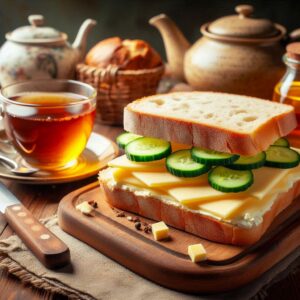German Butterbrot: A Slice of Tradition and Taste
German Butterbrot: A Culinary Staple
The German “Butterbrot” is more than just a slice of bread with butter. It’s a cultural icon, a canvas for creativity, and a beloved part of daily life. Let’s explore what makes this simple yet versatile dish so special.

A rustic slice of German white bread topped with creamy butter and fresh ingredients such as cheese and cucumber.
Historical Origins
The humble Butterbrot traces back centuries. In medieval times, peasants would eat simple bread with butter as a staple meal. It was sustenance—a way to fill hungry bellies during long days of labor. Over time, this basic combination evolved into an art form.
What Is a Butterbrot?
Originally, a Butterbrot was a plain slice of bread generously smeared with butter. Over time, it evolved into an open-faced sandwich, where toppings like cheese, spreads, or lunch meats are added. However, the key remains: it all starts with that buttered slice of bread.
Butter vs. Margarine: The Great Debate
Germans take their bread seriously. With around 300 different bread varieties, Germany leads the world in bread diversity. No wonder the Butterbrot holds a special place in their hearts. But what about the butter vs. margarine dilemma?
- Butter: Traditionalists swear by real butter. Its rich flavor and creamy texture elevate any topping.
- Margarine: Health-conscious eaters opt for margarine, which can be plant-based and lower in saturated fat.
Toppings Galore
Germans get creative with their Butterbrot. Here are some popular toppings:
- Cold Cuts: Thinly sliced ham, salami, or roast beef.
- Cheese: From mild Gouda to tangy blue cheese, the options are endless.
- Veggies: Fresh cucumber, juicy tomato, or crisp lettuce add crunch.
- Sweet Variations: Nutella, honey, or fruit preserves turn the Butterbrot into a sweet treat.
When to Enjoy?
- Breakfast: A classic morning choice, often paired with coffee or tea.
- Lunch: A quick and satisfying midday bite.
- Snack: Perfect for on-the-go or an afternoon pick-me-up.
A Recipe for German Butterbrot
Here’s a simple yet delightful Butterbrot recipe:
Ingredients:
- 1 slice of hearty German bread (rye or whole grain)
- 1 generous pat of butter
- Toppings of your choice (cold cuts, cheese, veggies, or sweet spreads)
Instructions:
- Toast the bread lightly if desired.
- Spread the butter evenly across the slice.
- Arrange your favorite toppings.
- Enjoy with a smile!
Whether you’re a butter purist or a margarine enthusiast, the German Butterbrot unites us all. It’s a slice of comfort, a nod to tradition, and a canvas for culinary creativity. So next time you reach for that crusty bread, remember: simplicity can be utterly delicious!
A Variety of German Breads
- Rye-Wheat (Roggenmischbrot): A hearty blend of rye and wheat flours, often with a dense texture and robust flavor.
- Toast Bread (Toastbrot): Light and fluffy, perfect for toasting or making sandwiches.
- Whole-Grain (Vollkornbrot): Nutrient-rich bread made from whole grains, providing a wholesome taste.
- Wheat-Rye (Weizenmischbrot): A balanced mix of wheat and rye, offering a mild flavor.
- White Bread (Weißbrot): Classic white bread, soft and versatile.
- Multigrain (Mehrkornbrot): A combination of wheat, rye, and oats, often with sesame or linseed for added crunch.
- Rye Bread (Roggenbrot): Dark, tangy, and full of character.
- Sunflower Seed Rye Bread (Sonnenblumenkernbrot): Packed with sunflower seeds for a delightful crunch.
- Pumpkin Seed Rye Bread (Kürbiskernbrot): Earthy and nutritious, with pumpkin seeds.
- Light Wheat-Rye Bread with Roasted Onions (Zwiebelbrot): A flavorful option with caramelized onion bits.
- Pumpernickel: The dark and nutty delight, made from coarsely ground whole rye grains, slow-baked to perfection.
These breads vary in taste, texture, and regional specialties. Whether you prefer a hearty slice with seeds or a light, fluffy loaf, German bakeries offer something for every palate. 🥯🌾

